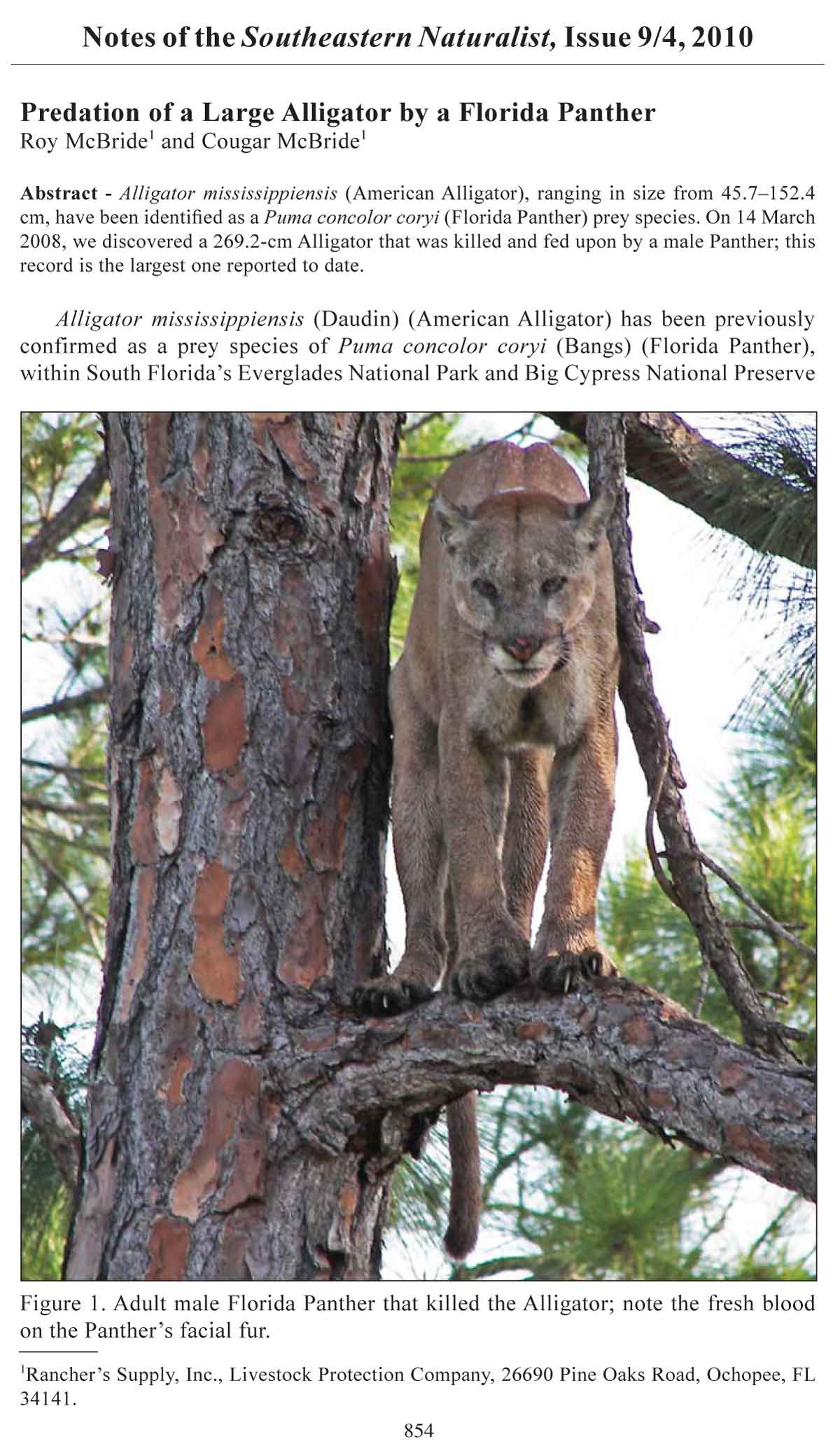825040 6 NOSoRuTthHeEaAstSeTrnE RNNat uNrAaTliUstR NAoLteISsT V13o(l.1 9):,3 N9–o4. 24
Predation of a Large Alligator by a Florida Panther
Roy McBride1 and Cougar McBride1
Abstract - Alligator mississippiensis (American Alligator), ranging in size from 45.7–152.4
cm, have been identified as a Puma concolor coryi (Florida Panther) prey species. On 14 March
2008, we discovered a 269.2-cm Alligator that was killed and fed upon by a male Panther; this
record is the largest one reported to date.
Alligator mississippiensis (Daudin) (American Alligator) has been previously
confirmed as a prey species of Puma concolor coryi (Bangs) (Florida Panther),
within South Florida’s Everglades National Park and Big Cypress National Preserve
Notes of the Southeastern Nat u ral ist, Issue 9/4, 2010
854
1Rancher’s Supply, Inc., Livestock Protection Company, 26690 Pine Oaks Road, Ochopee, fl34141.
Figure 1. Adult male Florida Panther that killed the Alligator; note the fresh blood
on the Panther’s facial fur.
2010 Southeastern Naturalist Notes 855
(Beier et al. 2003). A diet study conducted from 1984–1991 within Everglades
National Park, reported Alligator remains at Panther kill sites and in Panther scat
(Dalrymple and Bass 1996; D. Jansen, National Park Service - Big Cypress National
Preserve, Ochopee, fl, pers. comm.). Panther kill-site investigations within Big
Cypress National Preserve have also documented Alligator remains (D. Jansen and
J. Kellam, National Park Service - Big Cypress National Preserve, Ochopee, fl,
pers. comm.). In this biological note, we document the largest Alligator killed by a
Panther to date.
On 14 March 2008, while conducting our annual Panther survey within western
Big Cypress National Preserve, our hounds detected a cold Panther trail, which they
tracked silently for approximately two miles. The scent trail led to a strip of dense
vegetation where the hounds flushed the Panther out. After initially trying to escape
by crossing a flooded prairie, the Panther was overtaken on a pine island by the
hounds. We approached the sound of the barking hounds and observed an adult male
Panther approximately 10 m up on a limb of a Pinus elliottii Engelm. (Slash Pine)
(Fig. 1). At this point, our survey protocol required that we photograph the Panther,
acquire a GPS location and note any distinguishing characteristics for future identification. We noticed fresh blood on its lower jaw, which led us to assume the Panther
had a kill nearby. Searching the area, we discovered a blood trail and distinct drag
marks in the grass leading to the area where the hounds initially found the Panther. At
the terminus of the drag mark, we found the carcass of a freshly killed Alligator. The
Panther had fed on the ventral upper-thoracic cavity, exposing the tracheal region
(Fig. 2). Although a cursory necropsy was conducted, we were unable to determine
precisely how the Panther had killed the Alligator. It is worthwhile to note that the
tail of the alligator was intact, similar to our observations at other Alligator kill sites.
After photographing and measuring the carcass (269.2 cm TL), we followed the drag
Figure 2. American Alligator killed by the Panther; note that the feeding occurred
along the underside of the neck and not the tail.
856 Southeastern Naturalist Notes Vol. 9, No. 4
mark back approximately 80 m to the bank of a narrow slough where the Panther had
attacked the Alligator. Broken Panicum hemitomon J.A. Schultes (Maidencane) and
flattened grass graphically detailed the area where these two predators had struggled
at the waters edge. On 21 March 2008, at the request of Big Cypress National Preserve’s
wildlife biologist, Deborah Jansen, we returned to the kill site to recover
the skull of the Alligator and noted that the Panther had not returned to feed on the
carcass.
Acknowledgments. We thank the Florida Fish and Wildlife Conservation Commission
and the US Fish and Wildlife Service for funding our annual Panther survey,
and we thank John Kellam for his assistance with manuscript and photographic edits.
We appreciated and used the editorial recommendations of the journal’s reviewers
and subject editor.
Literature Cited
Beier, P., M.R. Vaughan, M.J. Conroy, and H. Quigley. 2003. An analysis of scientific literature
related to the Florida Panther. Final Report. Florida Fish and Wildlife Conservation Commission,
Tallahassee, fl.
Dalrymple, G.H., and O.L. Bass, Jr. 1996. The diet of the Florida Panther in Everglades National
Park, Florida. Bulletin of t the Florida Museum of Natural History 39(5):173–193.












 The Southeastern Naturalist is a peer-reviewed journal that covers all aspects of natural history within the southeastern United States. We welcome research articles, summary review papers, and observational notes.
The Southeastern Naturalist is a peer-reviewed journal that covers all aspects of natural history within the southeastern United States. We welcome research articles, summary review papers, and observational notes.